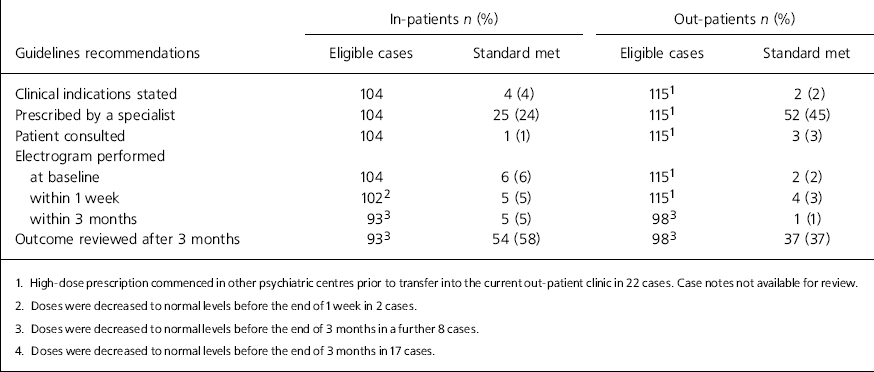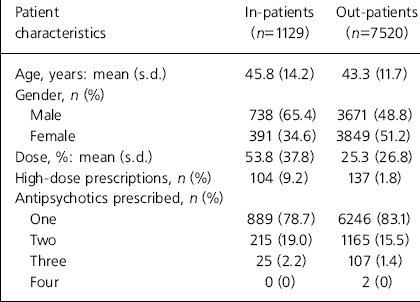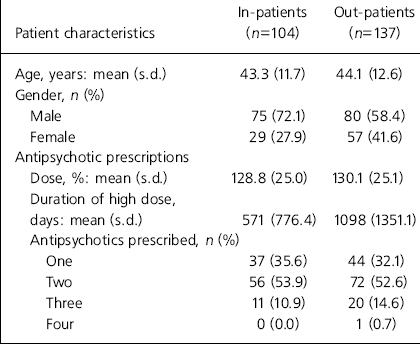High-dose antipsychotic prescribing is a common practice worldwide (Reference Diaz and De LeonDiaz & de Leon, 2002; Reference Harrington, Lelliott and PatonHarrington et al, 2002; Reference Bitter, Chou and UngvariBitter et al, 2003; Reference Chong, Tan and FujiiChong et al, 2004). In a recent study of 3132 in-patients in 47 UK adult mental health services, 20% were prescribed a total dose of antipsychotic medication above the British National Formulary (BNF) recommendations (Reference Harrington, Lelliott and PatonHarrington et al, 2002).
Recent reviews have failed to show any clinical benefit in prescribing high doses of antipsychotic medications (Reference Freudenreich and GoffFreudenreich & Goff, 2002; Reference Davis and ChenDavis & Chen, 2004). However, there is clear evidence to show the harmful effects of high-dose antipsychotic therapy. There is evidence to link mortality with antipsychotic dosage and polypharmacy (Reference Waddington, Youssef and KinsellaWaddington et al, 1998; Reference Joukamaa, Heliövaara and KnektJoukamaa et al, 2006).
The Royal College of Psychiatrists (2006) currently recommends the use of high doses only after evidence-based strategies have failed, and as a carefully monitored limited therapeutic trial.
Method
Study population
All in-patients and out-patients receiving psychiatric services in the New Territories West Cluster (NTWC) in Hong Kong who received antipsychotic medications on 15 November 2006 were included in this study. The NTWC covers a catchment area of 223.17 km2 with a population of 1.1 million inhabitants. Out-patients followed up prior to 15 November 2006 were included if antipsychotic medications were to be self-administered on that day.
A full range of psychiatric services are provided, including general adult, community, liaison, old age, child and adolescent, learning disability, forensic, early psychosis, substance misuse and perinatal psychiatry. This psychiatric service is an accredited training centre of the Royal College of Psychiatrists.
High-dose prescriptions
A high dose was defined as a total daily dose of a single antipsychotic exceeding the upper limit in the BNF. Where two or more antipsychotics are used, the prescribed dose is converted to a percentage of the maximum dose for each drug. If the sum of the percentages exceeds 100% the patient is receiving a high dose (Reference Yorston and PinneyYorston & Pinney, 2000; Royal College of Psychiatrists, 2006). For trifluoperazine, a maximum daily dose was set at 50 mg. The maximum dosage for thiothixene and ziprasidone, which are not available in the UK, were obtained from the US prescribing information published by the manufacturer.
Adherence to established guidelines
Where a high dose is prescribed, the Royal College of Psychiatrists (2006) recommends that:
-
(1) the clinical indications should be stated;
-
(2) the decision should be made by a fully trained psychiatrist;
-
(3) the patient should be consulted;
-
(4) electrocardiogram (ECG) should be performed at baseline, a few days after prescription, and every 1-3 months in the early stages of treatment; and
-
(5) the outcome should be reviewed after a 3-month trial, and the dose should be reduced back to conventional levels unless the clinical benefits outweigh the risks.
The case notes of all patients receiving a high dose were obtained to identify the extent to which these recommendations are followed in clinical practice.
Data collection
In-patient data were collected using a pro forma to collect information on all antipsychotic medications prescribed between 00.00 and 23.59 on 15 November 2006. Depot medications that were given prior to this date were included if this date fell within the period between successive injections. The prescribed dosage of ‘as required’ medications was obtained, in addition to the dosage dispensed by nursing staff. Out-patient prescription data were collected using the Clinical Management System database of the hospital authority, which processes and stores information on all out-patient prescriptions. A checklist was used to collect information from case notes to obtain further data and this is listed in Table 1.
Table 1. Adherence to guideline recommendations for cases receiving high-dose antipsychotic medications

| In-patients n (%) | Out-patients n (%) | |||
|---|---|---|---|---|
| Guidelines recommendations | Eligible cases | Standard met | Eligible cases | Standard met |
| Clinical indications stated | 104 | 4 (4) | 1151 | 2 (2) |
| Prescribed by a specialist | 104 | 25 (24) | 1151 | 52 (45) |
| Patient consulted | 104 | 1 (1) | 1151 | 3 (3) |
| Electrogram performed | ||||
| at baseline | 104 | 6 (6) | 1151 | 2 (2) |
| within 1 week | 1022 | 5 (5) | 1151 | 4 (3) |
| within 3 months | 933 | 5 (5) | 983 | 1 (1) |
| Outcome reviewed after 3 months | 933 | 54 (58) | 983 | 37 (37) |
Results
Demographic and prescription data
Demographic and prescription data were obtained from 1254 in-patients and 19 986 out-patients. Antipsychotic medications were prescribed to 1129 in-patients and 7520 out-patients. Of those receiving antipsychotic medications, high doses were prescribed to 9.2% of in-patients and 1.8% of out-patients. The findings are summarised in Tables 2 and 3.
Table 2. Demographic and prescription data: all patients prescribed antipsychotics

| Patient characteristics | In-patients (n=1129) | Out-patients (n=7520) |
|---|---|---|
| Age, years: mean (s.d.) | 45.8 (14.2) | 43.3 (11.7) |
| Gender, n (%) | ||
| Male | 738 (65.4) | 3671 (48.8) |
| Female | 391 (34.6) | 3849 (51.2) |
| Dose, %: mean (s.d.) | 53.8 (37.8) | 25.3 (26.8) |
| High-dose prescriptions, n (%) | 104 (9.2) | 137 (1.8) |
| Antipsychotics prescribed, n (%) | ||
| One | 889 (78.7) | 6246 (83.1) |
| Two | 215 (19.0) | 1165 (15.5) |
| Three | 25 (2.2) | 107 (1.4) |
| Four | 0 (0) | 2 (0) |
Table 3. Demographic and prescription data: patients receiving high-dose antipsychotic medications

| Patient characteristics | In-patients (n=104) | Out-patients (n=137) |
|---|---|---|
| Age, years: mean (s.d.) | 43.3 (11.7) | 44.1 (12.6) |
| Gender, n (%) | ||
| Male | 75 (72.1) | 80 (58.4) |
| Female | 29 (27.9) | 57 (41.6) |
| Antipsychotic prescriptions | ||
| Dose, %: mean (s.d.) | 128.8 (25.0) | 130.1 (25.1) |
| Duration of high dose, days: mean (s.d.) | 571 (776.4) | 1098 (1351.1) |
| Antipsychotics prescribed, n (%) | ||
| One | 37 (35.6) | 44 (32.1) |
| Two | 56 (53.9) | 72 (52.6) |
| Three | 11 (10.9) | 20 (14.6) |
| Four | 0 (0.0) | 1 (0.7) |
Discussion
Antipsychotic dosages
One antipsychotic was prescribed in 78.8% of in-patients and 83.1% of out-patients. This is in line with recommendations against the routine use of antipsychotic polypharmacy (Royal College of Psychiatrists, 2006). High doses were prescribed for 9.2% of all in-patients and 1.8% of all out-patients. A similar study conducted in the UK revealed 20% of in-patients receiving a high dose (Reference Harrington, Lelliott and PatonHarrington et al, 2002). Antipsychotic polypharmacy was also more common in patients prescribed a high dose. High doses had been prescribed for an average of 571 days for in-patients and 1098 days for out-patients.
Documentation, precautions and review
The case notes showed a general lack of documentation in patients receiving a high dose. Documentation of the indications for high-dose prescription was found in only six cases. Only three case notes recorded that the patient was informed, and very few patients received an ECG at baseline, 1 month, and 3 months after a high dose was prescribed. Due to a low index of suspicion or unawareness, the psychiatrist may have failed to realise that a patient was receiving a high dose. In addition, poor record-keeping and a lack of knowledge of the current recommendations regarding documentation, monitoring and review may have contributed to these findings. Further studies are required to identify and target factors leading to low adherence to guideline recommendations.
Limitations
This study was based on a large, representative population in Hong Kong, including both in-patients and out-patients. Although there were no private psychiatric hospitals or clinics in the catchment area, patients residing in the area may be receiving private psychiatric services elsewhere. These cases could not be identified for the purposes of this study. The cross-sectional design of this study does not provide any information on longitudinal patterns of prescription. This study did not investigate the reasons for high-dose antipsychotic prescription. The degree of awareness of the Royal College of Psychiatrists’ consensus statement (Royal College of Psychiatrists, 2006) was not assessed.
Medico-legal implications
A prescription exceeding the maximum recommended dose results in an unlicensed use of the medicine. A doctor who prescribes high-dose antipsychotic medications is likely to be held liable for damage caused to a patient, unless it can be shown that the damage was unrelated to the dosage prescribed. The existence of clear guidelines advising against the use of high-dose antipsychotic medications, together with poor documentation, a lack of patient consent and a lack of ECG monitoring will render many claims indefensible. The results of this study highlight the need for staff education and regular audit of antipsychotic doses in both the in-patient and out-patient setting.
Declaration of interest
None.
Acknowledgements
G.B.K.H. would like to thank Dr S. P. Leung, Consultant, Castle Park Hospital, for supervising and supporting this research. This paper is based on data collected for the Part III Examination of the Hong Kong College of Psychiatrists.






eLetters
No eLetters have been published for this article.